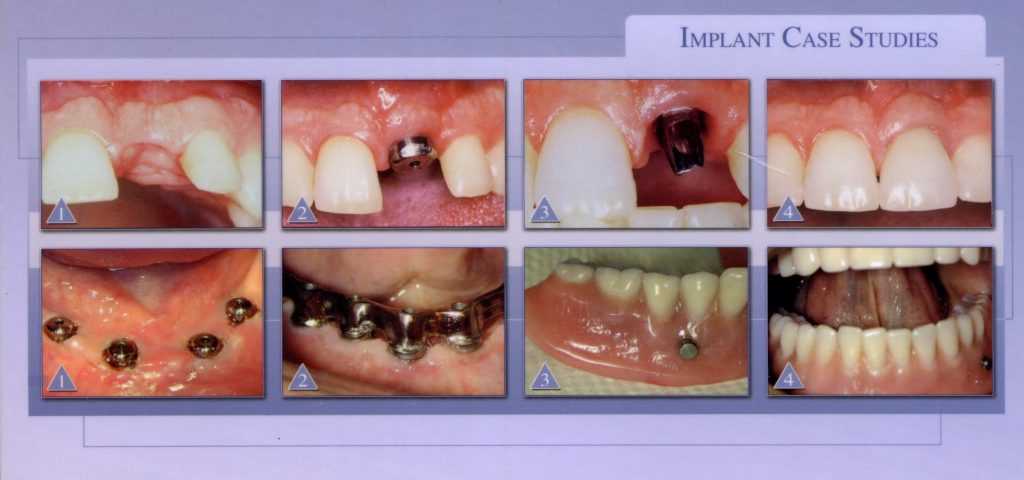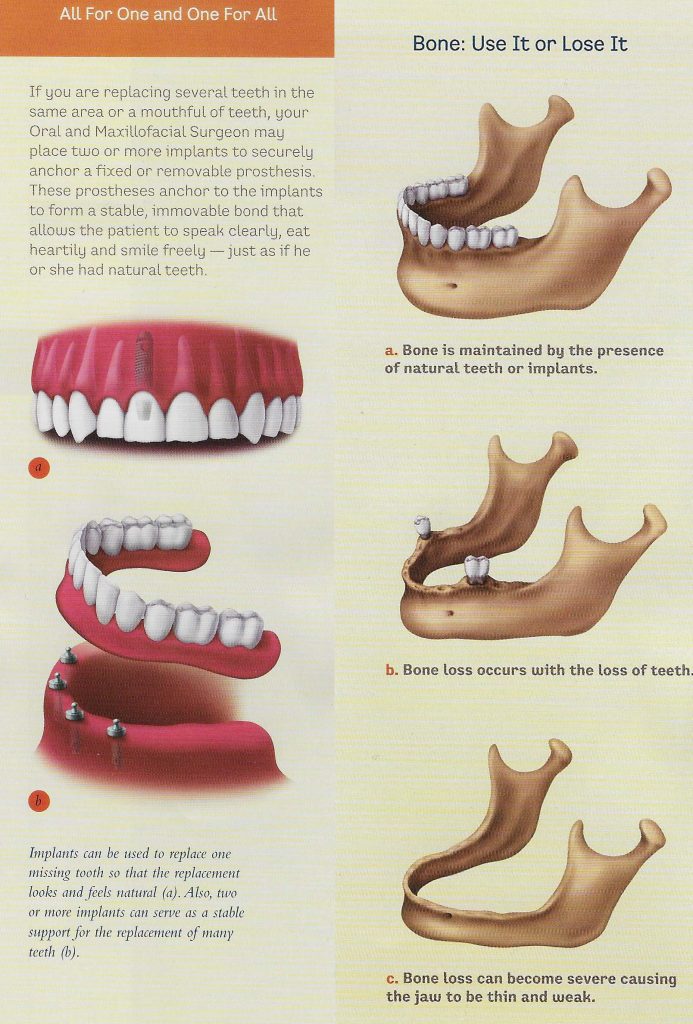Answers to Commonly Asked Questions:
- What are dental implants? Dental Implants are basically sophisticated screws made of a medically pure metal, Titanium. These screws are then placed in the jaw bone and rest under the gum for 3 – 6 months. During this time they actually fuse to the jawbone and become osseo(bone)integrated. After the appropriate healing time, we uncover the implants and use them to replace one or more missing teeth by fabricating some sort of dental prosthesis.
- How long have implants been used in dentistry? Dental implants have been available for the past 50 or so years. There are significant differences, however, between the various types of implants that have been used to replace missing teeth. These differences are important since they are directly related to the implants success rates. The implants currently in use today, OSSEOINTEGRATED IMPLANTS, were originally developed in Sweden by Dr. P.I. Branemark., a Swedish Orthopedist approximately 25-30 years ago. They have been used in the U.S. for the past 12 years.
- I understand they originated in Sweden? Is there a difference between the different implant manufacturers? All implants in use in the United States are regulated by the Food and Drug Administration. Originally, the only system available was the Noblepharma™ Branemark implant. Today, there are numerous implant companies in use on a daily basis. All of these companies are FDA approved and must meet very stringent requirements. Your dental team will choose the system that is best for you and the one that allows them to accomplish your mutual restorative goal.
- How complicated is the surgery? Implant surgery is done in two stages. The first stage involves the placement of the implants into the available jaw bone. This is most commonly done with just local anesthesia. It is complicated only in the sense that the surgery requires great precision. Every attempt is made to insure success. The room is set up similar to an operating room, the equipment thoroughly sterilized and the most modern techniques utilized. Stage two involves the uncovering of the implants after they have integrated ( fused ). This can be accomplished with minor gum surgery or with a dental laser and is a relatively minor procedure. In both instances, minimal postoperative discomfort is noticed. You will be given the appropriated antibiotics and analgesics just as a precaution. Very definitive postoperative instruction will be given to you at the time of surgery. If you follow the guidelines, everything should proceed without a hitch.
- Can implants be rejected? No! They are made of an inert metal which has no history of rejection by the body. They are not a living organ such as the lung or liver and therefore there is no rejection phenomenon. If failure should occur, and this is only a remote possibility, it is mechanical in nature and not due to rejection by the body. By the way, depending on the source you read, implants are anywhere from 85-95 percent successful depending upon certain factors such as implant location, amount and quality of bone etc. These factors will be evaluated before we place your implants. If you have any questions regarding this or any other aspect of the implant process, ask your dentist.
- If I lose several teeth, do they each have to be replaced with a separate implant? No. Although implants simulate the roots of teeth, biomechanically one implant can be used to replace one or more teeth. This will depend upon the mechanical requirements of your chosen prosthesis. At your consultation your dentist will discuss the various treatment alternatives and the type and number of implants that are needed in order to fulfill our treatment objectives.
- What about infection and complications? During the surgery every attempt is made to maintain a totally sterile field. This tends to minimize any potential for postoperative infection. Once again, your dentist will prescribe the appropriate antibiotics as a precautionary measure. Once the implants have been engaged in your prosthesis, it is imperative for you to maintain scrupulous oral hygiene. Success very often depends on your cooperation and homecare efforts.
- What types of restorations can be placed on implants? The answer to this question depends upon your treatment objectives. This can vary from simple removable prostheses, using the implants for retention , to totally implant supported porcelain fused to metal crowns and bridges. Implant bridges can be either removable or fixed (not removable) depending upon the number of implants. We are now finally able to replace single or multiple missing teeth returning the dentition to a biologically healthy and esthetically pleasing state.
- How long is the entire implant process? Dental implants take approximately 3-4 months in the lower jaw and 6 months in the upper to integrate. Once integrated, it takes several visits to several months to complete the restoration depending upon the complexity.
- What is the cost? The cost of implant dentistry is based upon a combination of the surgical phase and the prosthetic phase. Your total treatment fee will depend upon the number of implants and the complexity of your final restoration.
We hope that this brief explanation will answer some of your questions regarding implant dentistry. Your dentist will be happy to discuss any of these questions with you at your consultation. Please write down your questions so that we can be sure to answer them to your satisfaction.

HOME CARE INSTRUCTIONS
The care of your Implant Prosthesis consists of three steps
- Educating and training you about proper oral hygiene techniques.
- Removal of plaque and calculus (tartar) on a regularly scheduled basis by your Hygienist.
- Maintaining meticulous oral hygiene between your recall visits.
Home plaque control is a critical component of your dental implant care. The following devices have proved extremely helpful in plaque removal and as tools in the proper maintenance of dental implant/prostheses
- Soft Toothbrush, End Tuft Brush, Proxy Brush™
- Dental Floss( i.e. Post Care Dental Implant Floss, SuperFloss™ )
- Rotadent™
- Oral Irrigation Devices ( i.e. Water Pik™)
- Mouthwashes containing essential oils ( i.e. Listerine™ )
Individual Instruction sheets are available for each of the above mentioned cleaning aids. Your dentist and hygienist are also available to assist you in any way they can. Remember, it’s not the tool that counts, but the elbow grease behind it.
The proper maintenance of your dental implant prosthesis must be a good blend of proper hygiene technique, appropriate instrumentation and adequate frequency. Your hygienist will suggest a suitable recall schedule for you based upon the complexity of your dental restoration. She or he will also demonstrate each and every technique so that you can become familiar with the tools that are required for implant care. Then it’s up to you. With a little effort, your dental implant prosthesis can provide.

